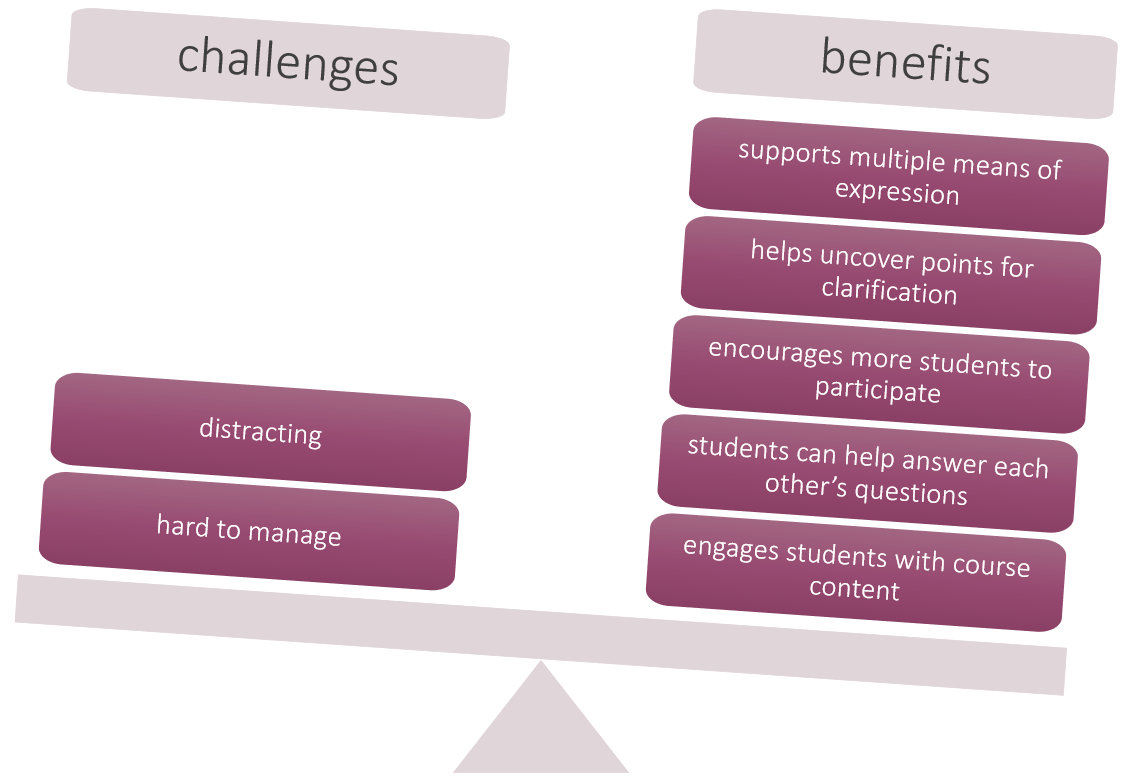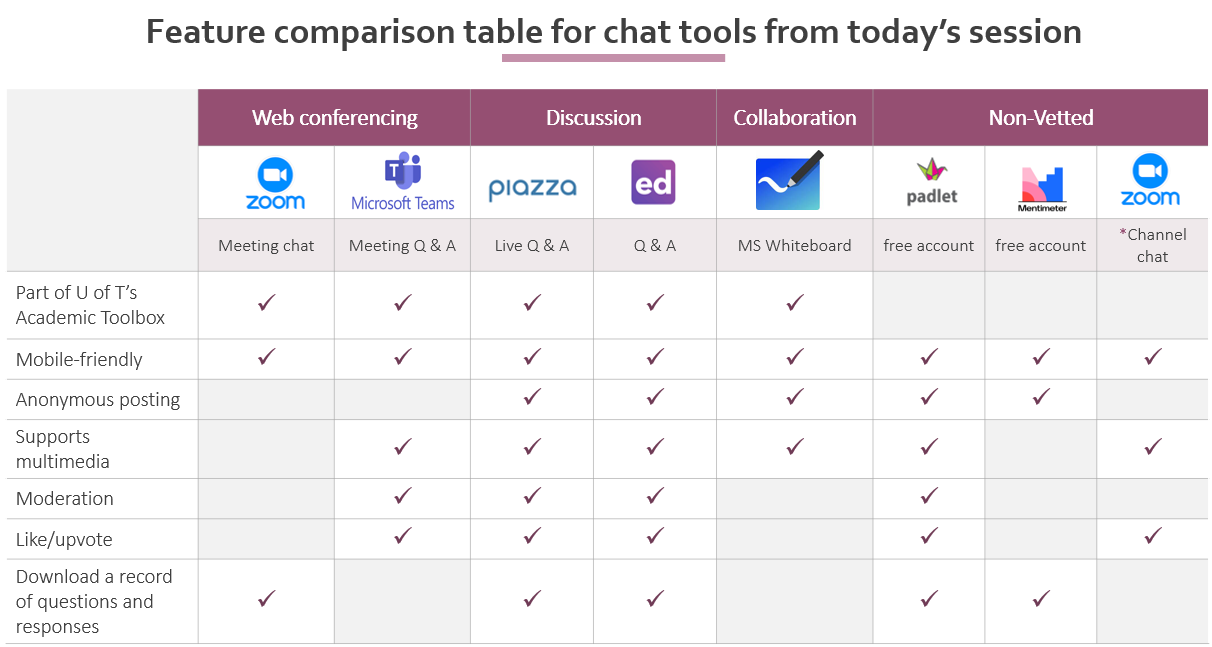On August 17, 2022, Anna facilitated the ETO's first in-person ETO session in...well, a while! The session focused on bringing a popular feature of online synchronous sessions into the physical classroom: the backchannel chat.
This blog reviews the session (the slide deck used for this session is included at the bottom of this post) and includes the rationale (why you might choose to translate the benefits of online chatting to your physical classoom), considerations for implementation (what do you need to think about before you do this?), its uses, examples of tools (we compare different vetted (and some un-vetted) tools you could implement in your course) and we end with some recommendations. As always, we encourage you to consider your own style of teaching and your course goals - this type of tool isn't for everyone but if it fits with your course, can encourage more diverse student participation.
Want to review the slide deck used in the session? You can review and download the PDF "Let's Chat about Chatting!: Opening a Digital Backchannel in your On-Campus Courses"
Jump to:
- The Rationale: Why use a backchannel chat in class?
- The Benefits: What does the research say?
- The Considerations: What are some advantages and disadvantages in using backchannel chats?
- The Selection: Questions to help you select the right tool
- The Implementation: How can you support successful implementation?
- The Tool Examples: What tools can I use to implement a chat in my class?
- The Recommendations: A quick review of the ETO's key recommendations while using a backchannel chat
- References
What exactly is a backchannel?
From 7 Things You Should Know About Backchannel Communication (Educause, 2010):
- “…a secondary electronic conversation that takes place at the same time as a conference session, lecture, or instructor-led learning activity”
- “Increasingly …being brought into the foreground as a formal part of lecture interaction as speakers actively encourage audience members to join in with questions or comments, sharing their feedback with one another without disrupting the speaker”
The Rationale: Why use a backchannel chat in class?
Pre-COVID In-person vs. Remote Teaching: Pre-Covid, in-class participation typically meant a few students (often the same ones) would raise their hand to ask or respond to questions. The instructor would then respond to a few of those questions, one at a time. When teaching went remote at the height of the pandemic, some instructors observed increase in student participation via chat in Teams or Zoom. With an online chat tool, multiple students could now participate at the same time, as well as interact with their peers. Instructors found that asking students to participate via chat not only increased participation, it also made it easier for them to identify patterns in the students' questions and pull out items for further discussion and follow-up teaching. Now, with the recent return to on-campus classes, instructors are wondering how to preserve some of these positive features in their physical classrooms.
The Benefits: What does the research say?
- “…students felt more comfortable asking and answering questions in online classes, suggesting that there might be features of learning online to which students are receptive, and which may also benefit in-person classes.” (Hollister B, Nair P, Hill-Lindsay S, and Chukoskie L (2022))
- “…text interaction in which students asked questions or made comments in the LVC (Live Virtual Classroom) chat box during the instructor’s lectures was a preferred mode of interaction for students when they were participating both online and onsite.” (Vu and Fadde (2013))
These observations are backed by some studies. For example, Hollister et al (2022) surveyed the online learning experience of undergraduate students (n = 187) at the University of California in San Diego. They found that while a "majority of students reported that they struggled with staying connected to their peers and instructors and managing the pace of coursework" most felt more comfortable asking and responding to questions in online classes versus in-person. Similarly, Castelli and Sarvary (2021) write that instructors "had great success using the chat feature within Zoom" with some reporting that "individuals that did not often speak when class was in-person were suddenly more communicative when using the chat feature online". These findings extend previous observations by Vu and Fadde (2013). Thos authors found that graduate design students attending both in-person and online classes for the same course preferred using the chat feature to answer questions, regardless of whether they were attending in-person or online.
The Considerations: What are some advantages and disadvantages in using backchannel chats?

Disadvantages to using chat include:
- Too distracting for you: can be difficult to monitor side conversations while trying to present class content
- Too distracting for students: the chat can veer off topic making it difficult for students to manage attention to the class topic (e.g., if students share links and resources (not necessarily topic-related) that others then click on)
Advantages to using chat include:
- Engages students with course content: thinking and asking questions about class content can serve as a form of retrieval practice for all students (not just the ones who might typically volunteer a response or get called on in class)
- Students can help each answer each other's questions: strengthen's peer-to-peer interactions and helps build community, can also take some of the load off the instructor (especially for questions around course logistics/administration)
- Encourages more students to participate: allows more students to participate at the same time, compared to a typical in-class approach where only one student can speak at a time and not everyone will get a chance to weigh in
- Helps uncover points for clarification: getting more responses can help you identify patterns in topics students need clarified
- Supports multiple means of expression: students who are not comfortable raisng their hands and speaking out have an alternate way to engage
The diagram (featuring scales that show a heavier weight towards the advantages of chat) suggest that the pluses of incorporating a backchannel chat outweight the minuses. This might not be the case for your particular class and requires further individual consideration. But let's assume that you've gone ahead and decided to incorporate some type of chat into your classes and let's look at some additional questions that will help you select the right tool for your context.
The Selection: Questions to help you select the right tool
We recommend asking yourself these questions:
- Is this platform accessible?
- Do I want the ability to moderate comments before making them visible to everyone?
- Will I be projecting comments/question on screen during class?
- Do I want students to be able to respond to each other’s posts?
- Should students be able to like or upvote each other’sposts?
- Do I want the chat to have a structure (with specific prompts/questions/topics)?
- Should the students have the option to post anonymously?
- Do I need to save the comments/responses?
- Will I assign a participation grade to responses?
The answers will help you decide how you will use chat in your class and the tools that will make this work for you.
The Selection: Find the right balance for your class
Based on how you responded earlier, you might need to decide the level of restrictions you want to apply in your chats (Levy, 2020). This may depend on different aspects of you class, including year of study and number of students in the class.

Type of chat |
Details |
|---|---|
|
Free flowing chat |
|
|
Focused chat |
|
| Responses to specific Instructor prompts and questions |
|
The Implementation: How can you support successful implementation?
Below are a tips to help you prepare yourself, your teaching team, and your students for using this type of tool. We recommend sending these out via a class announcement as well as verbally reminding students before you use the tool for the first time.
- Set clear guidelines and expectations for behaviour and participation
- Tell students how and when you will view and respond to their posts, and if they can respond to each other
- Assign a moderator (e.g., a TA or peer moderator) to point out common questions/ideas and to signal inappropriate comments
- Decide if the backchannel will be projected in the room or only viewed on students’ own devices
- Set expectations including how long you expect the typical answer to be (a few words or one to two sentences is likely ideal, especially in larger classes, and will make it easier to collect and respond to the comments more quickly)
- Consider how many students you expect to contribute (the more students you expect to contribute, the more structure you will likely need in the question/prompt and the shorter the student responses should be)
- Remind everyone to disable noise notifications (you don't want to hear a "bing" for every chat message)
The Tool Examples: What tools can I use to implement a chat in my class?
Below are the tools that were highlighted during the in-person version of this session. If you're thinking about using an un-vetted tool, read this first: Tips to safely implement un-vetted tools in your course.

*Although currently available with a U of T Zoom License, Zoom's channel chat feature has not been approved for inclusion in the Academic Toolbox
Looking for an accessible version of the table? See the text version of the Let's Chat about Chatting Tool Comparison Table.
NOTE: As of Fall 2023, ED discussion tool is no longer available as an integrated and supported tool in the UofT Academic Toolbox. View CTSI's Online Discussion Tools page for a list of supported Discussion tools.
The Recommendations: A quick review of the ETO's key recommendations while using a backchannel chat
- Set (and communicate) clear expectations: Provide guidelines for participation & model appropriate responses
-
Make it intentional: Relate any question prompts to course content and outcomes.
-
Check in: Make time for periodic and consistent chat check-ins by chunking lecture content.
-
Follow up: Complement backchannel with an exit ticket for additional questions.
References
Castelli, F.R., & Sarvary, M. A. (2021). Why students do not turn on their video cameras during online classes and an equitable and inclusive plan to encourage them to do so. Ecology and Evolution. https://doi.org/10.1002/ece3.7123
Hollister, B., Nair, P., Hill-Lindsay, S. & Chukoskie, L. (2022) Engagement in Online Learning: Student Attitudes and Behavior During COVID-19. Frontiers in Education. 7:851019. https://doi.org/10.3389/feduc.2022.851019
Levy, Dan.(2020). Teaching Effectively with Zoom: A practical guide to engage your students and help them learn.
Vu, P., and Fadde, P. (2013). When to talk, when to chat: Student interactions in live virtual classrooms. Journal of Interactive Online Learning. 12, 41–52.
7 Things You Should Know About Backchannel Communication (Educause, 2010)